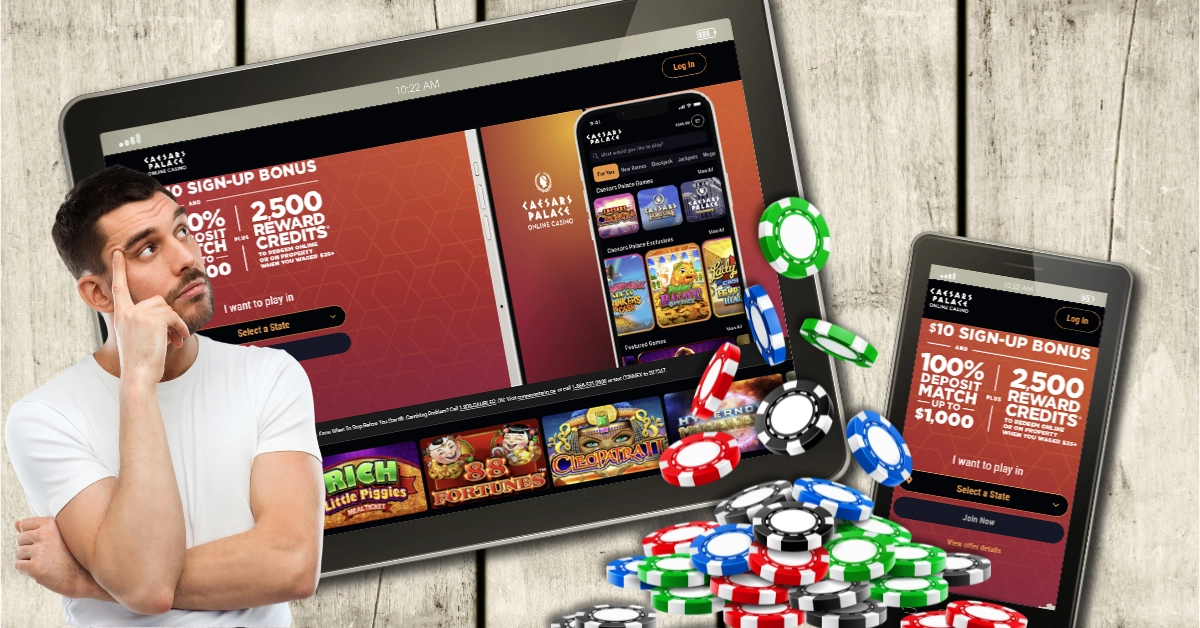Gambling on Tablets vs. Smartphones: Which Is Better?

Mobile gaming took the world by storm when smartphones implemented games—remember the Candy Crush fanaticism? Everywhere you looked, someone was crushing some candy on their mobile.
And although the graphics were good in the earlier days, they’ve gone full throttle in the last few years. Especially now that you can gamble for real money instead of playing a game that only gives you points! It’s changed casual moments into full-on entertainment sessions. From spinning slots to crushing puzzles or emerging victorious in an intense battle, a lot of us are glued to our devices for all of the gaming fun. But that begs the big question: Which one is the better gaming device—a smartphone or a tablet?
Sure, each one has its own pros and cons for gambling. Do you want portability, or do you want to play on a bigger screen? Is there one that is ultimately better than the other? We want to find out, so we are gonna explore all of the device features, gaming performance, and the ups and downs of both options in order to help you choose which one is worthy of your gaming loyalty!
Mobile Gambling Trends: Tablets vs. Smartphones
Mobile gaming is bigger than ever! Why? Obviously, because smartphones and tablets all have a huge variety of gaming experiences for users. They can play quick puzzle games during coffee breaks to full-blown strategy sessions—the devices have totally changed how we play. But is one the real MVP of mobile gaming?

Statistics and Growth Trends
The numbers are clear—mobile gaming just keeps on growing. With the market expected to reach $164 billion in the next few years, millions of players are picking up their devices for entertainment. Smartphones have dominated the space, with over half of gamers using iPhones or Androids to play. Tablets, on the other hand, are favored by about a quarter of gamers, especially those who want to play on a bigger screen.
User Preferences
Who’s playing, and what are they playing? Well, most men are drawn to sports, strategy, and racing games, while women veer toward trivia, word puzzles, and more casual games. Younger players usually go for quick-hit games like trivia, and older audiences lean toward board and casino games. Tablets usually attract players who are looking for more immersive experiences, and phones come out on top and are the go-to for quick and easy play.
Main Features Comparison
The choice between a tablet and a smartphone for gaming us def a personal preference—but you also have to factor in your gaming habits! There are differences in how they stack up in terms of screen size, portability, and battery life, which we get into below!
Screen Size and Display Quality
Let’s talk screen size and display quality because they matter depending on the games you play!
Tablets win big in the screen size department—they have displays that go from 7 to 12 inches. The added real estate is great for more immersive gameplay, as it lets you fully enjoy the super-detailed graphics of strategy games, RPGs, or any visually demanding title. Tablets usually come installed with higher resolution displays and technologies like HDR, which means that colors will pop and make sure that every single detail is seen (and heard).
Smartphones might have smaller screens—typically 5 to 7 inches—but their advancements in display technology are really impressive. High pixel density, OLED or AMOLED screens, and features like adaptive refresh rates make gaming sharp, fluid, and visually stunning. Smartphones are now designed for clarity and portability, proving that even on a smaller screen, you can still have a premium gaming experience.
Portability
You think that gamers are only playing at home? Wrong! They are playing on public transportation, at school (between classes, of course), and in waiting rooms. How easily a device can tag along on these adventures is a big deal. Here’s how tablets and smartphones compare when it comes to portability:
Size does matter, and while the bigger tablets improve the gaming experience, they are a little less practical for gaming on the go. They’re bulkier, need a bag or case for transporting them safely (you don’t want scratches), and are best suited for use at home or when you are stationary. If you’re someone who likes to settle into a comfy spot corner and get really into a game, tablets are a solid choice.
Smartphones are your BFF travel buddies. Small enough to fit in a pocket or bag, they’re perfect for gaming during commutes, during a 10 minute work break, or a quick sesh between a task. Their lightweight design makes them the more practical option for gamers who are always on the move.
Battery Life
Games are a drain on any device’s battery, but the way smartphones and tablets handle it can vary in the following ways:
Tablets generally have larger batteries, meaning they are able to support longer gaming sessions without requiring a recharge. But the larger screens and higher resolutions don’t save your battery strain—they still deplete power pretty quickly during gaming. On average, tablets do tend to last a little longer under gaming conditions compared to smartphones, but they’re not immune to power-hungry games.
Smartphones do have smaller batteries, but modern devices also come equipped with power-saving features and adaptive settings that can optimize performance during gaming. That said, high-performance games can still take a big toll on a battery, especially if they are paired with features like 5G and high refresh rates. Frequent gamers will find themselves reaching for a charger more often with a smartphone.
Gaming Performance
Gaming success can come down to visuals, speed, and a strong internet connection. Tablets and smartphones take on these demands differently, and both have their own strengths—it all depends on your gaming style! Want to see how they compare? Look below to find out!
Processing Power and Graphics
Both tablets and smartphones have the capability to deliver impressive performances, but there are some differences in how they handle the heaviest games.
High-end tablets are equipped with strong processors and GPUs that handle graphically demanding games with ease. Here are some examples:
– Genshin Impact is amazing on tablets, as it has a smoother exploration of its expansive open world and colorful combat.
– Civilization VI benefits from the larger screen in terms of managing intricate strategy and city-building gameplay.
– Casino games like Zynga Poker or Jackpot Party Slots feel so much more immersive, with larger touch controls and high-resolution graphics that mimic the look and feel of a physical casino.
– Devices like the iPad Pro, with its M2 chip, and the Samsung Galaxy Tab S9, featuring Snapdragon 8 Gen 2, provide seamless gameplay and superior graphical fidelity. Tablets also tend to stay cooler during prolonged gaming sessions due to their larger bodies and more advanced cooling systems.
Smartphones sure have come a long way in gaming performance, and there are flagship models that rival a lot of tablets in the realm of speed and visual quality. Examples include the following:
– Call of Duty Mobile, which performs exceptionally well on devices like the ASUS ROG Phone 7, has super smooth frame rates and responsive controls.
– Candy Crush Saga and Coin Master are both optimized for fast, casual play on smaller screens.
– Real-money casino apps like BetMGM Casino and Caesars Palace Slots also run seamlessly, as they have been designed with smartphone ergonomics in mind for single-handed gambling.
– Modern smartphones like the iPhone 15 Pro Max, powered by the A17 Pro chip, or the Samsung Galaxy S23 Ultra can handle the latest AAA mobile games, and they pretty much match tablets in visual clarity and responsiveness.
Game Compatibility
There are certain games that are just better suited for one device over the other, and that’s due to screen size, controls, or hardware optimization!
Games that necessitate detailed attention or benefit from a larger display will always look and work better on tablets, like the ones listed below!
– XCOM 2 Collection and Divinity: Original Sin 2 have intricate interfaces and text-heavy gameplay, and both benefit from a bigger screen.
– Online casino games like 888poker and Roulette Royale are designed to replicate the immersive feel of real casino tables, which translates nicely on larger displays.
– Digital board games like Settlers of Catan or Carcassonne feel so much more natural on tablets, especially if you’re doing multiplayer sessions.
Fast-paced, pick-up-and-play games are a natural fit for smartphones, as they’re designed for portability and short bursts of gameplay! Some of the best include the following:
– Among Us absolutely thrives on smaller screens— quick decision-making and portability keep you connected to all of the action.
– Real-money gambling sites, like FanDuel Casino, are optimized for smartphones, making it super easy to place bets or spin slots while you are out and about.
– Games like PUBG Mobile or Free Fire have also been designed with small-screen gameplay in mind, and they have smooth controls and high-quality visuals.
Internet Connectivity
A stable internet connection is a must for online gaming, and both tablets and smartphones handle this need differently!
Wi-Fi vs. Cellular Gaming Experiences
Tablets, while capable of both Wi-Fi and cellular connections (if equipped), always rely more on Wi-Fi networks. Wi-Fi-only tablets will limit gaming opportunities when a strong network isn’t available, and that makes them less flexible for gamers when they aren’t at home.
Smartphones have an edge in connectivity—almost all modern phones have the ability to switch between Wi-Fi and cellular networks seamlessly, and that guarantees uninterrupted gaming no matter where you are.
Device Size and Signal Strength
Tablets, while undoubtedly powerful, will sometimes struggle with connectivity because of their size and larger antenna configurations. But they do excel in stable Wi-Fi conditions, which makes them great for at-home or fixed-location gaming.
Smartphones are designed with optimized antenna placement to sustain strong connections in all kinds of environments. This makes them a great choice for multiplayer games like Clash Royale or online poker tournaments on apps like PokerStars Casino.
Pros and Cons of Gaming on Tablets
Tablets definitely bring their own flavor to gaming, as they mix convenience and performance—but there are a few trade-offs you should consider. Depending on what you’re looking for in a gaming device, they could be a match—or not. Below, we weigh the perks and the hmmm, maybe nots.
Pros
Tablets have some outstanding advantages that can elevate your gaming experience in ways smartphones just can’t live up to!
- Bigger Display for Better Visuals: Tablets’ large screens give you more than just size—they deliver an immersive canvas for your fav games. It doesn’t matter if you are exploring open worlds in Genshin Impact or spinning away to your heart’s content in Jackpot Party Slots; the bigger the display, the more you can soak in every single detail.
- Better Multitasking Options: Have you ever needed to consult a walkthrough when you are in the middle of a game? Tablets make it possible and easy with their split-screen functionality. You can game on one half of the screen while checking a guide or watching a tutorial on YouTube on the other half. It’s particularly handy for strategy games or RPGs that can call for some research or tips mid-play.
- Comfort During Long Gaming Sessions: The larger form factor of tablets gives you a more ergonomic grip for extended playtime. If you’re grinding through a lengthy RPG or playing a high-stakes poker match, your hands and eyes will thank you for even a little extra comfort.
Cons
As great as tablets are, they’re certainly not without a few downsides! The following are a couple of things of things that you should consider when choosing:
- Less Portability: Tablets aren’t exactly pocket-friendly, and schlepping one around means bringing an extra bag or case, which isn’t great if you want to sneak in a quick game and have to rummage around to find it. Their size definitely makes them better suited for home gaming than any on-the-go adventures.
- Higher Cost: The higher-quality gaming tablets do not come cheap. Premium models like the iPad Pro or Samsung Galaxy Tab S9 can set you back a fair amount, especially when you compare them to the cost of a decent gaming smartphone. If you’re on a budget, this could possibly be a dealbreaker.
Pros and Cons of Gaming on Smartphones
Smartphones literally put a whole world of entertainment in your pocket and your hands! And while they do bring a lot to the gaming table, they also have their downsides, just like tablets do. Let’s get into the ups and downs of gambling on these amazing portable powerhouses!
Pros
Smartphones come fully loaded with features that make gambling not only convenient but genuinely fun!
Compact and Ready to Go Anywhere: Smartphones are the ultimate portable gaming devices. You can sneak in a quick game of Subway Surfers while you are on the subway or try your luck on PokerStars Casino while you’re riding shotgun—smartphones make gaming ridiculously accessible. Their compact size means you don’t need a bag or special case—they go wherever you do.
- Massive Game Library Across Genres: Thanks to their widespread adoption, smartphones have an unmatched range of games. From hyper-casual hits like Candy Crush Saga to AAA mobile titles like Diablo Immortal, there’s literally something for every kind of gamer. Casinos like BetMGM Casino and 888poker also thrive here, as they are tailored for the quick, intuitive interactions that smartphones excel at. The app stores are overflowing with options, so you will probably never run out of choices.
- Advanced Features That Boost Gameplay: Modern smartphones all come equipped with cutting-edge features that elevate gaming. Haptic feedback, which is found in devices like the iPhone 15 Pro, adds subtle vibrations that mimic in-game actions, making gameplay so much more immersive. And if you’re into augmented reality (AR) gaming, the advanced cameras on smartphones take games like Pokémon GO and Ingress to a whole ‘nother level, as they add digital characters right into your surroundings!
Cons
Smartphones are great for, but they are far from perfect! Below are the few trade-offs you should think about.
- Smaller Screens Limit Immersion: While portability is a win, it comes at the cost of screen size. Playing visually rich games like Genshin Impact or text-heavy RPGs on a smaller display can feel cramped or like you are missing out on the bigger picture. Detailed menus or complex controls are much harder to manage on a compact screen, and that can take away from the whole experience.
- Battery Drains Fast: Look, gaming is a battery hog, and smartphones don’t usually hold up under pressure. Games with high frame rates or online multiplayer features, like Call of Duty Mobile or casino apps running live games, can drain your battery in no time flat. This is also super inconvenient if your phone is also your main device for work or communication!
Yes, smartphones do come with incredible convenience and versatility, but their limitations mean they might not always be the best option for long or immersive gaming sessions. For quick fun on the go, though, they’re actually hard to beat.
Gaming Scenarios: Which Device Fits the Need?
Gaming definitely isn’t a one-size-fits-all-player activity—it’s as different as the devices we choose to play on! If you want something casual and quick or a more immersive, strategic experience, the device you pick really does matter. Tablets and smartphones both excel in their own ways, and it all depends on the type of game and where you’re playing. Let’s match the device to the situation, shall we?
Casual Gaming
Smartphones are hands down the MVPs of casual gaming—they’re built for simplicity and speed.
Casual games are convenient, and smartphones deliver just that. With so many games, like Angry Birds, Two Dots, or Trivia Crack, just to name a few, you can start playing in seconds, no matter where you are. The games don’t demand hours of your time or total concentration; they’re made for fast entertainment. The compact size of a smartphone makes it effortless to carry your fav games in your pocket, and they are ready to go whenever you feel like playing.
Casino and Gambling Games
For the full casino experience, tablets give you an edge—you get more screen space and much better navigation.

If you’re spinning slot reels on House of Fun or playing an intense round of live blackjack on Betway Casino, tablets give players a super immersive experience. Live dealer games feel closer to reality on a tablet, and you are able to clearly see the dealer and interact with betting options without having to squint at a smaller screen. Slots lovers will also appreciate the improved graphics and smoother controls on games like DoubleU Casino. Poker players, too, will probably find tablets better for managing multiple tables or tracking the finer details of a hand in apps like Zynga Poker.
Competitive/Esports Gaming
Okay, in this category, both devices bring something to the table for serious, competitive gaming—it all depends on the type of game you’re into!
Strategy and precision games prosper on tablets. For titles like Hearthstone, Legends of Runeterra, or Teamfight Tactics, the extra screen space gives you a crystal clear view of your cards, board, or teammates, and that means better decision-making. Multiplayer strategy games like League of Legends: Wild Rift also feel much more accessible, and that’s thanks to easier navigation of more complex in-game menus and controls. Tablets give competitive players the clarity they need to focus on the finer details that can mean the difference between winning and losing!
If fast reflexes and quick movements are what you want, smartphones are up to the task. Games like Call of Duty Mobile or Brawl Stars are built with smartphone players in mind, as they have smooth controls and a snappy performance. Devices like the ASUS ROG Phone or iPhone 15 Pro Max have super high refresh rates, advanced cooling systems, and responsive touch screens that give competitive gamers an extra edge in the heat of battle. Plus, their portability means you can practice and compete from almost anywhere.
Travel Gaming
Gaming on the move? If so, smartphones are the ultimate travel buddy!
Traveling with a tablet isn’t a huge ordeal, but carrying something that fits perfectly in your pocket is kind of unbeatable. Smartphones let you sneak in gaming sessions without worrying about extra bags or chargers. Titles like Hill Climb Racing 2, Fruit Ninja, or Monument Valley are great for fast bursts of fun while you’re waiting for a flight or on a long train ride. Even more involved games like Genshin Impact or Marvel Snap can keep you entertained for hours—just make sure you bring a portable power bank along so you can keep your phone up and running!
Cost Considerations
As for device prices, there are a lot of options! And you have to think about more than the advertised sticker price when you are trying to choose the right device for you—and if it’s realistically in your budget. Tablets and smartphones vary wildly in cost, and when you factor in accessories, the price can go up really quick! Below, we will break it down so you won’t get a case of sticker shock.
Device Pricing
Tablets and smartphones both come in a range of prices—there are budget-friendly options and high-end powerhouses.
– Budget Range: Entry-level tablets like the Amazon Fire HD 10 can be as cheap as $75 during sales.
– Mid-Range: The Samsung Galaxy Tab S9 FE sits comfortably around $500, and that means it balances performance and price.
– High-End: Premium tablets like the iPad Pro (12.9-inch) can hit $1,300 or more, especially if you add extras like the Apple Pencil or Magic Keyboard.
– Budget Range: Affordable smartphones, like the Samsung Galaxy A14, start at around $200.
– Mid-Range: Popular models like the Google Pixel 8 or Samsung Galaxy S23 fall between $600 and $900.
– High-End: The latest iPhone 15 Pro Max can set you back about $1,600 if you opt for the top storage one, and that makes it one of the most expensive gaming-friendly phones.
As for raw pricing, smartphones tend to span a bigger range, wnd budget options are much more accessible. Tablets, on the other hand, can seem like a bigger upfront investment, especially if you’re eyeing up the premium models.
Accessory Costs
If you are looking to optimize your gaming setup truly, accessories are a must. The following is what you might want to budget for:
– Smartphones: The Razer Kishi V2 and Backbone One are really popular choices for smartphones, as they turn your device into a handheld console. They typically cost between $80 and $120.
– Tablets: For tablets, you’ll likely need a standalone Bluetooth controller, like the Xbox Wireless Controller or DualShock 4, which are around $60 each.
– Smartphones: Compact phone stands or grips are super affordable and portable, and they range from $10 to $30. And they are great for propping up your phone during long sessions!
– Tablets: Sturdier stands are important for larger screens and can cost anywhere between $30 and $70–it all depends on adjustability and build quality.
Chargers and Power Banks
- Gaming drains your battery fast, so investing in a reliable charger or power bank is something you’re gonna need to do. A good power bank with fast-charging capabilities (10,000mAh or more) will set you back anywhere from $25 to $75.
Additional Considerations
- In-Game Purchases: Both smartphones and tablets always encourage spending through in-game purchases. The average mobile gamer spends roughly $60 per year on things like skins, loot boxes, or extra levels and lives.
- Longevity and Upgrades: Smartphones typically have shorter upgrade cycles—around 2-3 years—while tablets can last longer, especially for casual gamers. Keep in mind that upgrading a flagship phone, like the iPhone 15 or Galaxy S24 Ultra, every few years could cost you a lot more over time compared to a mid-range tablet.
Conclusion
Making a choice between a tablet and a smartphone for your gaming ultimately depends on what matters most to you!
Let’s do a quick recap of the main differences between the devices:
Tablets
- Bigger screens make them much better for more immersive gameplay and any visually detailed games.
- Perfect for strategy, RPGs, and casino games that require a little more precision.
- They are better for long gaming sessions, as they give you ergonomic comfort and a longer battery life.
Smartphones
- They are compact and portable, which makes them ideal for gaming while you are out and about.
- Excellent for casual and fast-paced games like shooters or arcade-style titles.
- Usually more affordable upfront, and they have a massive library of accessible and fun games.
Your choice all boils down to your gaming habits, lifestyle, and budget. Are you a casual gamer who wants convenience? Or do you want a super immersive setup for in-depth gaming sessions?
Tell us your go-to gaming device, and share with us why you love it in the comments! You never know, your experience could help someone else decide on which one to choose for gaming instead of having to read through hundreds of Reddit threads or reviews.
FAQ
Gaming on tablets and smartphones comes with a ton of options, but it also comes with questions. Below are the most common FAQs our readers have asked. And if there’s anything else you’re curious about, please let us know!
Can I Play the Same Games on Both Tablets and Smartphones?
Yup, in most cases! Most popular games, like Genshin Impact, Candy Crush Saga, and Call of Duty Mobile, are available on both platforms. Some apps do optimize the user experience differently based on the device. Like a tablet could have more detailed menus or larger touch controls, and a smartphone will have simplified layouts for smaller screens.
Which Device Is Better for Casino Games?
Tablets usually provide a better experience for casino games, especially for live dealer games or titles with detailed interfaces. A bigger screen makes it easier to see the betting options, follow the action, and navigate menus. That being said, don’t sleep on smartphones for quick spins on slots or casual games!
Are Gaming Accessories Compatible with Both Tablets and Smartphones?
Most accessories, like Bluetooth controllers (e.g., Xbox or DualShock), work with both tablets and smartphones. Some accessories, like clip-on controllers like the Backbone One, are specifically designed for smartphones and won’t fit the larger tablets. Always check that it’s compatible with your device before you click that purchase button!
How Do I Optimize Gaming Performance on My Device?
To get the best gaming experience, do the following:
– Close all background apps to free up RAM and processing power.
– Lower the in-game graphics settings on mid-range devices so you can improve performance and lessen any lag.
– Use a cooling stand or fan during longer gaming sessions in order to prevent overheating.
– Make sure your device’s software is up to date, as updates usually come with performance improvements.

Alyssa contributes sportsbook/online casino reviews, but she also stays on top of any industry news, precisely that of the sports betting market. She’s been an avid sports bettor for many years and has experienced success in growing her bankroll by striking when the iron was hot. In particular, she loves betting on football and basketball at the professional and college levels.







